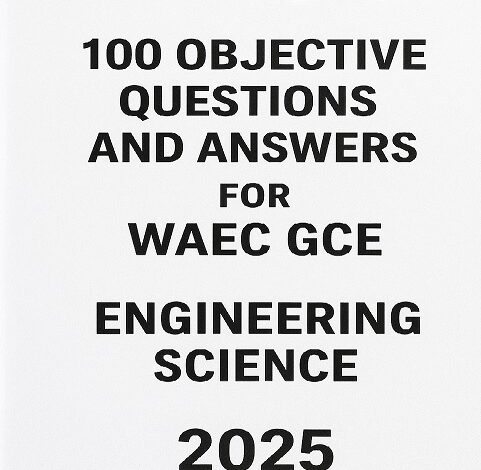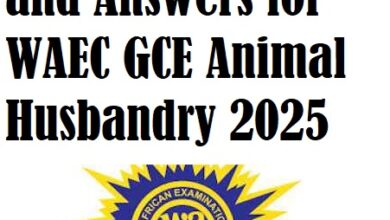100 Objective Questions and Answers for WAEC GCE Engineering Science 2025

100 Objective Questions and Answers for WAEC GCE Engineering Science 2025
ENGINEERING SCIENCE 1 (OBJECTIVE) – 2025 WAEC GCE PRACTICE QUESTIONS AND ANSWERS
Section A: Mechanics
-
The unit of force is
A. Joule
B. Newton
C. Watt
D. Pascal
Answer: B -
The moment of a force is the product of the force and its
A. direction
B. distance from the pivot
C. mass
D. velocity
Answer: B -
A body in equilibrium has
A. balanced forces acting on it
B. only one force acting on it
C. no mass
D. constant acceleration
Answer: A -
The mechanical advantage of a machine is given by
A. Load × Effort
B. Effort / Load
C. Load / Effort
D. 1 / (Load × Effort)
Answer: C -
A lever with the fulcrum between the load and effort is a
A. first-class lever
B. second-class lever
C. third-class lever
D. compound lever
Answer: A -
A car accelerates from rest to 20 m/s in 10 s. Its acceleration is
A. 0.5 m/s²
B. 1 m/s²
C. 2 m/s²
D. 4 m/s²
Answer: C -
The SI unit of work is
A. Watt
B. Joule
C. Newton
D. Ampere
Answer: B -
A machine whose efficiency is 80 % and mechanical advantage 4 has a velocity ratio of
A. 3.2
B. 4
C. 5
D. 4.8
Answer: C -
The energy possessed by a moving body is
A. potential energy
B. electrical energy
C. kinetic energy
D. solar energy
Answer: C -
The center of gravity of a uniform meter rule lies at
A. 10 cm
B. 25 cm
C. 50 cm
D. 75 cm
Answer: C
100 Objective Questions and Answers for WAEC GCE Engineering Science 2025
Section B: Heat and Thermodynamics
-
The instrument used to measure temperature is
A. hygrometer
B. thermometer
C. barometer
D. hydrometer
Answer: B -
The SI unit of heat is
A. Joule
B. Watt
C. Newton
D. Calorie
Answer: A -
Conduction occurs mainly in
A. solids
B. liquids
C. gases
D. vacuums
Answer: A -
The process by which liquids change to vapour below their boiling point is
A. condensation
B. evaporation
C. sublimation
D. melting
Answer: B -
The fixed temperature at which a pure solid changes to liquid is
A. melting point
B. boiling point
C. freezing point
D. latent point
Answer: A -
The heat required to raise the temperature of a unit mass of a substance by 1 K is
A. latent heat
B. specific heat capacity
C. thermal conductivity
D. heat capacity
Answer: B -
A substance that resists the flow of heat is a
A. conductor
B. insulator
C. radiator
D. thermostat
Answer: B -
The temperature at which water boils at sea level is
A. 0 °C
B. 25 °C
C. 50 °C
D. 100 °C
Answer: D -
Heat transfer through a vacuum occurs by
A. conduction
B. convection
C. radiation
D. evaporation
Answer: C -
A rise in temperature causes most metals to
A. contract
B. expand
C. cool
D. melt
Answer: B
Section C: Light and Optics
-
The speed of light in air is approximately
A. 3 × 10⁸ m/s
B. 3 × 10⁵ m/s
C. 3 × 10⁶ m/s
D. 3 × 10⁷ m/s
Answer: A -
The law of reflection states that
A. angle of incidence = angle of reflection
B. angle of incidence > angle of reflection
C. light bends at all surfaces
D. light travels in circles
Answer: A -
The image formed by a plane mirror is
A. real and inverted
B. virtual and erect
C. magnified
D. diminished
Answer: B -
A concave mirror is used as
A. rear-view mirror
B. shaving mirror
C. door mirror
D. wall mirror
Answer: B -
Refraction occurs because light
A. changes speed when entering another medium
B. changes color
C. is absorbed
D. disappears
Answer: A -
The refractive index of a medium is the ratio of
A. angle of refraction to incidence
B. sine of incidence to sine of refraction
C. speed of light in medium to speed in air
D. speed in air to speed in medium
Answer: D -
A convex lens is also known as a
A. converging lens
B. diverging lens
C. cylindrical lens
D. prism
Answer: A -
The focal length of a lens is
A. the distance from optical center to focus
B. half its radius
C. its aperture
D. its diameter
Answer: A -
The unit of focal length is
A. candela
B. diopter
C. meter
D. lumen
Answer: C -
A periscope uses
A. lenses only
B. mirrors only
C. prism only
D. both mirrors and lenses
Answer: B
100 Objective Questions and Answers for WAEC GCE Engineering Science 2025
Section D: Sound and Waves
-
Sound cannot travel through
A. solids
B. liquids
C. gases
D. vacuum
Answer: D -
The pitch of a sound depends on its
A. frequency
B. amplitude
C. speed
D. wavelength
Answer: A -
The loudness of sound depends on
A. frequency
B. amplitude
C. wavelength
D. phase
Answer: B -
The unit of frequency is
A. Hertz
B. Joule
C. Pascal
D. Ohm
Answer: A -
The echo of sound is due to
A. refraction
B. reflection
C. diffraction
D. interference
Answer: B -
Resonance occurs when
A. two bodies vibrate at the same frequency
B. frequency is zero
C. there is interference
D. amplitude is small
Answer: A -
The speed of sound in air at room temperature is about
A. 150 m/s
B. 330 m/s
C. 500 m/s
D. 1000 m/s
Answer: B -
The human ear can detect frequencies between
A. 20 Hz – 20 kHz
B. 1 Hz – 10 Hz
C. 100 Hz – 50 kHz
D. 200 Hz – 100 kHz
Answer: A -
A tuning fork produces sound by
A. reflection
B. vibration
C. conduction
D. radiation
Answer: B -
Ultrasonic waves have frequencies
A. below 20 Hz
B. above 20 kHz
C. between 20 – 200 Hz
D. between 1 – 10 kHz
Answer: B
Section E: Electricity and Magnetism
-
The flow of electric charge through a conductor is called
A. voltage
B. current
C. resistance
D. capacitance
Answer: B -
The unit of electric current is
A. Watt
B. Volt
C. Ohm
D. Ampere
Answer: D -
The unit of resistance is
A. Coulomb
B. Ohm
C. Watt
D. Henry
Answer: B -
Ohm’s law states that current is directly proportional to
A. resistance
B. voltage
C. power
D. time
Answer: B -
In a series circuit, the total resistance is
A. sum of all resistances
B. product of all resistances
C. reciprocal of all resistances
D. difference between resistances
Answer: A -
In a parallel circuit, the voltage across each resistor is
A. the same
B. different
C. twice the supply voltage
D. zero
Answer: A -
Electrical power is given by the formula
A. P = VI
B. P = IR
C. P = I²R
D. P = V/R
Answer: A -
The unit of electrical energy used by the power company is
A. joule
B. kilowatt-hour
C. watt-second
D. volt-ampere
Answer: B -
When a north pole of a magnet is brought near the north pole of another magnet, they
A. attract
B. repel
C. neutralize
D. rotate
Answer: B -
The Earth itself behaves like a
A. giant conductor
B. giant magnet
C. transformer
D. capacitor
Answer: B -
A device that converts mechanical energy into electrical energy is a
A. motor
B. generator
C. transformer
D. capacitor
Answer: B -
The magnetic field inside a solenoid increases when
A. current decreases
B. number of turns decreases
C. current increases
D. the core is removed
Answer: C -
The instrument used to measure current is
A. voltmeter
B. ammeter
C. galvanometer
D. wattmeter
Answer: B -
The unit of potential difference is
A. volt
B. ampere
C. coulomb
D. ohm
Answer: A -
In a transformer, the core is laminated to
A. increase resistance
B. reduce eddy current loss
C. make it lighter
D. increase magnetic flux
Answer: B -
A step-up transformer increases
A. current
B. voltage
C. resistance
D. power
Answer: B -
The function of a fuse in an electric circuit is to
A. increase voltage
B. prevent short circuit
C. increase current
D. store charge
Answer: B -
The ability of a material to oppose the flow of current is
A. conductance
B. resistance
C. capacitance
D. inductance
Answer: B -
The material used for electric wiring is usually
A. iron
B. copper
C. zinc
D. aluminum
Answer: B -
The unit of capacitance is
A. farad
B. henry
C. ohm
D. volt
Answer: A
100 Objective Questions and Answers for WAEC GCE Engineering Science 2025
Section F: Workshop Technology and Materials
-
The process of heating and cooling metals to obtain desired properties is called
A. tempering
B. forging
C. casting
D. machining
Answer: A -
The main purpose of annealing is to
A. harden the metal
B. soften the metal
C. polish the metal
D. rustproof the metal
Answer: B -
The tool used for measuring small internal diameters is a
A. micrometer screw gauge
B. vernier caliper
C. inside caliper
D. steel rule
Answer: C -
A file removes material by
A. melting
B. cutting
C. grinding
D. chiseling
Answer: B -
The process of joining two metals by heating and adding filler metal is
A. soldering
B. brazing
C. welding
D. riveting
Answer: C -
The device that converts electrical energy to mechanical motion is a
A. generator
B. transformer
C. motor
D. solenoid
Answer: C -
The blacksmith’s main tool is a
A. lathe
B. hammer
C. file
D. chisel
Answer: B -
The part of a lathe that holds and rotates the workpiece is the
A. headstock
B. tailstock
C. carriage
D. bed
Answer: A -
The abrasive material used in grinding wheels is known as
A. flux
B. grit
C. filler
D. slag
Answer: B -
The most common metal used in engineering construction is
A. copper
B. aluminum
C. steel
D. zinc
Answer: C -
The process of removing sharp edges from a workpiece is called
A. filing
B. deburring
C. turning
D. lapping
Answer: B -
Safety goggles are used to
A. enhance beauty
B. protect the eyes from particles
C. identify workers
D. magnify the workpiece
Answer: B -
The tool used to check flatness of a surface is a
A. surface gauge
B. try square
C. vernier height gauge
D. caliper
Answer: B -
The flux used in soft soldering is usually
A. zinc chloride
B. sodium chloride
C. calcium carbonate
D. ammonium sulfate
Answer: A -
A lathe operates on the principle of
A. reciprocation
B. rotation
C. vibration
D. percussion
Answer: B
Section G: Applied Mechanics and General Principles
-
The resultant of two equal forces acting at 90° is
A. same as each force
B. twice each force
C. √2 times each force
D. zero
Answer: C -
The unit of pressure is
A. Pascal
B. Joule
C. Watt
D. Henry
Answer: A -
Pressure in a liquid increases with
A. height
B. depth
C. temperature
D. surface area
Answer: B -
The instrument used to measure atmospheric pressure is a
A. thermometer
B. barometer
C. manometer
D. hygrometer
Answer: B -
The hydraulic jack works on the principle of
A. Bernoulli
B. Pascal
C. Newton
D. Archimedes
Answer: B -
The principle of flotation was discovered by
A. Pascal
B. Newton
C. Archimedes
D. Boyle
Answer: C -
The ratio of load lifted to effort applied in a machine is
A. efficiency
B. mechanical advantage
C. velocity ratio
D. torque
Answer: B -
The efficiency of a perfect machine is
A. 50%
B. 80%
C. 100%
D. 120%
Answer: C -
The point where the whole weight of a body appears to act is called
A. center of mass
B. center of gravity
C. pivot
D. hinge
Answer: B -
The mass of a body is a measure of its
A. volume
B. inertia
C. weight
D. density
Answer: B -
The unit of momentum is
A. Ns
B. J/s
C. W/m²
D. kgm²/s²
Answer: A -
The instrument used to measure mass is
A. spring balance
B. beam balance
C. ammeter
D. hydrometer
Answer: B -
The acceleration due to gravity on Earth is approximately
A. 9.8 m/s²
B. 8.9 m/s²
C. 10.8 m/s²
D. 9.2 m/s²
Answer: A -
A body floats when its
A. weight > upthrust
B. weight = upthrust
C. weight < upthrust
D. mass is zero
Answer: B -
The law of conservation of energy states that energy
A. can be created
B. cannot be destroyed
C. can be lost
D. exists only in machines
Answer: B
100 Objective Questions and Answers for WAEC GCE Engineering Science 2025
Section H: General Engineering Science and Instruments
-
A galvanometer measures
A. large currents
B. small currents
C. resistance
D. voltage
Answer: B -
The function of a rheostat is to
A. store current
B. vary current
C. generate voltage
D. rectify current
Answer: B -
The component that stores electrical charge is a
A. inductor
B. capacitor
C. diode
D. resistor
Answer: B -
A diode allows current to flow in
A. one direction
B. both directions
C. no direction
D. alternating direction only
Answer: A -
The earth wire is usually colored
A. blue
B. brown
C. green/yellow
D. red
Answer: C -
The function of a circuit breaker is to
A. step up voltage
B. act as safety switch
C. supply power
D. store energy
Answer: B -
The tool used to check voltage in an electrical circuit is
A. ammeter
B. voltmeter
C. galvanometer
D. ohmmeter
Answer: B -
The rate of doing work is called
A. energy
B. power
C. force
D. heat
Answer: B -
Efficiency is expressed as
A. input/output × 100
B. output/input × 100
C. work/time
D. load/effort
Answer: B -
The SI base unit of energy is
A. joule
B. watt
C. volt
D. ohm
Answer: A
ENGINEERING SCIENCE 2 (ESSAY) – 2025 WAEC GCE PRACTICE QUESTIONS
Question 1 – Mechanics (Forces and Equilibrium)
(a) Define the term moment of a force.
(b) State the conditions necessary for equilibrium of a rigid body under the action of parallel forces.
(c) A uniform beam of length 4 m and weight 50 N is supported at its ends. A load of 30 N is placed 1.5 m from one end. Find the reactions at the supports.
Marking Guide / Expected Points:
-
Definition of moment of a force (2 marks)
-
Conditions for equilibrium (2 marks)
-
Correct diagram and free-body setup (2 marks)
-
Calculation of reactions (4 marks)
Total: 10 marks
Question 2 – Heat and Thermodynamics
(a) Explain the three modes of heat transfer and give one example of each.
(b) State two applications of good conductors and two of good insulators in engineering.
(c) Explain why double-walled flasks are used to store hot liquids.
Marking Guide / Expected Points:
-
Description of conduction, convection, radiation (6 marks)
-
Examples and applications (2 marks)
-
Explanation of vacuum insulation in flasks (2 marks)
Total: 10 marks
Question 3 – Simple Machines
(a) Define mechanical advantage and velocity ratio.
(b) Derive the relationship between efficiency, mechanical advantage, and velocity ratio.
(c) A machine lifts a load of 200 N through a distance of 2 m when an effort of 50 N moves through 10 m. Find:
(i) Mechanical advantage
(ii) Velocity ratio
(iii) Efficiency
Marking Guide / Expected Points:
-
Definitions (3 marks)
-
Derivation (2 marks)
-
Correct calculations (5 marks)
Total: 10 marks
Question 4 – Electricity and Magnetism
(a) State Ohm’s Law.
(b) Sketch and label a simple circuit used to verify Ohm’s Law.
(c) A resistor of 10 Ω carries a current of 2 A. Find the potential difference across it.
(d) Explain what happens to the current if the resistance is doubled while voltage remains constant.
Marking Guide / Expected Points:
-
Law statement (2 marks)
-
Circuit diagram (3 marks)
-
Calculation (2 marks)
-
Explanation (3 marks)
Total: 10 marks
100 Objective Questions and Answers for WAEC GCE Engineering Science 2025
Question 5 – Optics (Light)
(a) Define refraction of light.
(b) State Snell’s law and explain the term refractive index.
(c) Draw a neat diagram to show refraction through a rectangular glass block.
(d) A ray of light enters a glass slab at an angle of incidence 30°, and the angle of refraction is 20°. Calculate the refractive index of glass.
Marking Guide / Expected Points:
-
Definition (2 marks)
-
Snell’s law (2 marks)
-
Diagram (2 marks)
-
Calculation: n = sin i / sin r = sin30°/sin20° (≈1.46) (4 marks)
Total: 10 marks
Question 6 – Heat Capacity and Change of State
(a) Define specific heat capacity.
(b) Explain what is meant by latent heat of fusion.
(c) A 0.5 kg block of ice at 0°C is melted by heat energy of 168,000 J. Calculate the specific latent heat of fusion of ice.
(d) State one practical application of latent heat in refrigeration.
Marking Guide / Expected Points:
-
Definition of specific heat capacity (2 marks)
-
Explanation of latent heat (2 marks)
-
Calculation L=Q/m=168000/0.5=336000 J/kgL = Q/m = 168000 / 0.5 = 336000 \, J/kg (4 marks)
-
Application (2 marks)
Total: 10 marks
Question 7 – Sound and Vibrations
(a) State two differences between noise and musical sound.
(b) Explain the term resonance with one example.
(c) List three factors that affect the frequency of vibration of a stretched string.
Marking Guide / Expected Points:
-
Differences between noise and sound (2 marks)
-
Explanation of resonance (4 marks)
-
Factors (length, tension, mass per unit length) (4 marks)
Total: 10 marks
100 Objective Questions and Answers for WAEC GCE Engineering Science 2025
Question 8 – Workshop Practice and Tools
(a) Describe three safety precautions to be observed in a mechanical workshop.
(b) Name and state one use each of the following tools:
(i) Vernier caliper
(ii) Micrometer screw gauge
(iii) Try square
(c) Explain why personal protective equipment (PPE) is important in workshop practice.
Marking Guide / Expected Points:
-
Safety precautions (3 marks)
-
Tools and uses (4 marks)
-
PPE explanation (3 marks)
Total: 10 marks
Question 9 – Energy and Power
(a) Define work, power, and energy.
(b) A 100 W motor lifts a load of 50 N vertically through 4 m. Calculate the time taken.
(c) Differentiate between potential and kinetic energy with one example each.
Marking Guide / Expected Points:
-
Definitions (3 marks)
-
Calculation t=(Work/Power)=(50×4)/100=2 st = (Work/Power) = (50 × 4)/100 = 2 \, s (3 marks)
-
Differences with examples (4 marks)
Total: 10 marks
Question 10 – Materials Science
(a) Define the following terms:
(i) Elasticity
(ii) Plasticity
(iii) Hardness
(b) State three ways of improving the hardness of steel.
(c) Explain the difference between ferrous and non-ferrous metals with one example each.
Marking Guide / Expected Points:
-
Definitions (3 marks)
-
Methods of hardening (heat treatment, carburizing, quenching) (3 marks)
-
Explanation and examples (4 marks)
Total: 10 marks



